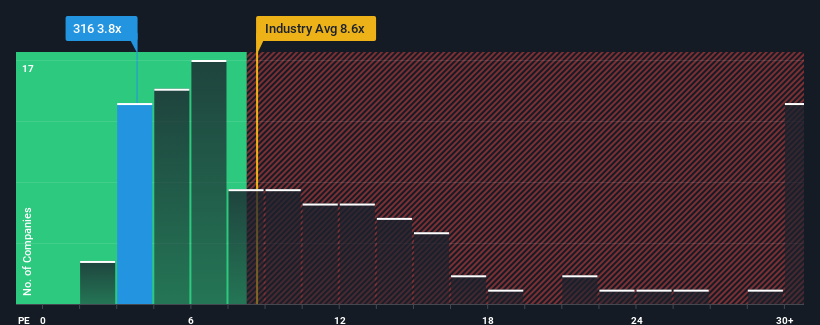
Orient Overseas (International) Limited's (HKG:316) price-to-earnings (or "P/E") ratio of 3.8x might make it look like a strong buy right now compared to the market in Hong Kong, where around half of the companies have P/E ratios above 11x and even P/E's above 23x are quite common. However, the P/E might be quite low for a reason and it requires further investigation to determine if it's justified.
Recent times have been advantageous for Orient Overseas (International) as its earnings have been rising faster than most other companies. One possibility is that the P/E is low because investors think this strong earnings performance might be less impressive moving forward. If not, then existing shareholders have reason to be quite optimistic about the future direction of the share price.
See our latest analysis for Orient Overseas (International)

How Is Orient Overseas (International)'s Growth Trending?
There's an inherent assumption that a company should far underperform the market for P/E ratios like Orient Overseas (International)'s to be considered reasonable.
Taking a look back first, we see that the company grew earnings per share by an impressive 88% last year. Still, incredibly EPS has fallen 65% in total from three years ago, which is quite disappointing. Therefore, it's fair to say the earnings growth recently has been undesirable for the company.
Turning to the outlook, the next three years should bring diminished returns, with earnings decreasing 32% per year as estimated by the six analysts watching the company. Meanwhile, the broader market is forecast to expand by 12% per annum, which paints a poor picture.
With this information, we are not surprised that Orient Overseas (International) is trading at a P/E lower than the market. Nonetheless, there's no guarantee the P/E has reached a floor yet with earnings going in reverse. There's potential for the P/E to fall to even lower levels if the company doesn't improve its profitability.
What We Can Learn From Orient Overseas (International)'s P/E?
Using the price-to-earnings ratio alone to determine if you should sell your stock isn't sensible, however it can be a practical guide to the company's future prospects.
As we suspected, our examination of Orient Overseas (International)'s analyst forecasts revealed that its outlook for shrinking earnings is contributing to its low P/E. Right now shareholders are accepting the low P/E as they concede future earnings probably won't provide any pleasant surprises. Unless these conditions improve, they will continue to form a barrier for the share price around these levels.
We don't want to rain on the parade too much, but we did also find 2 warning signs for Orient Overseas (International) (1 shouldn't be ignored!) that you need to be mindful of.
Of course, you might also be able to find a better stock than Orient Overseas (International). So you may wish to see this free collection of other companies that have reasonable P/E ratios and have grown earnings strongly.
Have feedback on this article? Concerned about the content? Get in touch with us directly. Alternatively, email editorial-team (at) simplywallst.com.
This article by Simply Wall St is general in nature. We provide commentary based on historical data and analyst forecasts only using an unbiased methodology and our articles are not intended to be financial advice. It does not constitute a recommendation to buy or sell any stock, and does not take account of your objectives, or your financial situation. We aim to bring you long-term focused analysis driven by fundamental data. Note that our analysis may not factor in the latest price-sensitive company announcements or qualitative material. Simply Wall St has no position in any stocks mentioned.